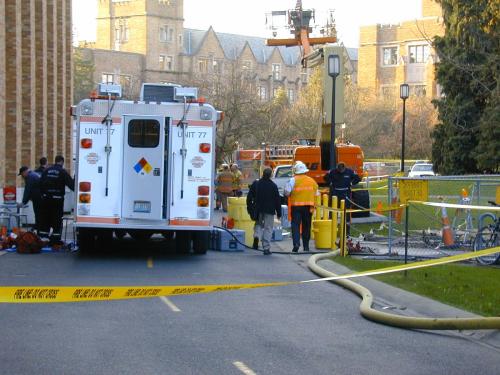Labs, shops and other locations that use chemicals must comply with the hazardous materials provisions of the International Fire Code. This code limits quantities of certain chemicals based upon the physical and health hazards of the chemical, and establishes requirements for storage and use.
Environmental Health & Safety (EH&S) provides information, resources and tools to meet the requirements of the International Fire Code for proper storage, use and disposal of hazardous materials. Hazardous materials generally refers to chemicals, compressed gases, and cryogenic fluids that present physical and health hazards.
Chemical inventories
The primary tool used to maintain compliance and safety is the University’s MyChem system. It compares quantities of hazardous materials present on campus to the fire code maximum allowable limits. These limits can vary by a number of factors, including the presence of fire sprinklers, location (indoor versus outdoor), storage cabinets and floor level.
- Keeping a current inventory of your chemicals in MyChem allows us to monitor for compliance and prepare hazardous materials inventory statements for the fire department.
- The MyChem system also acts as a repository for safety data sheets used during emergencies.
- Chemical inventories are used by EH&S to assist with applications for new building permits and initial fire code operating permits. Construction project managers may contact EH&S for assistance with gathering hazardous materials inventory statement information.
Fire code permits
Depending on the quantity, certain chemical hazard classes require permits from the local fire department.
Departments with multiple labs in the same building should consider consolidating their lab permits. Consolidated permits reduce the administrative burden of permit applications, renewals and inspections for both the University and the fire department, and may also reduce permit fees.
Permit applications and conditions that must be followed within the City of Seattle are available on the Seattle Fire Department web site.
Contact EH&S for information and assistance with permits.
Lab and research spaces
General safety information associated with hazardous materials for existing lab spaces can be found in your laboratory safety manual. If your lab does not yet have a specific laboratory safety manual you can download information and a template in the UW Laboratory Safety Manual.
Architects and lab planners designing new lab spaces should refer to the design guides on the UW Facilities Design Standard website.
Services available
EH&S can help you use and store chemicals to achieve and maintain compliance with complex fire code requirements.
Contact us for general consultation on fire code requirements for:
- Fire code permits
- Chemical storage
- Toxic gas and low oxygen alarm systems
- Separation of incompatible materials
- Compressed gas piping and plumbing
- Seismic protection for chemicals
- Spill control and secondary containment
- Emergency planning and procedures
- Local ventilation control and vacuum systems
- Classified electrical systems
- Safety and warning signage
Emergency response and reporting
UW personnel are required to submit an incident report to Environmental Health & Safety for any work-related event that results in an injury, illness, exposure to hazardous materials, or fire, regardless of the work location.
UW personnel are highly encouraged to submit work-related near-miss events. Visit the Incident Reporting page for more information.
Regulation and policy
Chapter 50 of the Seattle Fire Code
Frequently asked questions
Not necessarily. If the labs are in the same building and under single control, one permit may be able to cover them all especially if a single source can be identified to pay the permit fee.
Consolidated permits reduce the administrative burden of permit applications, renewals and inspections for both the University and the fire department. Fees may be based on quantities of materials and/or the number of control areas covered. Some buildings have prorated fees by lab space to charge back to grants or other operating funds.
It is not required but many are vented to reduce odor build-up that can occur within the cabinet. Venting must be installed correctly so that the fire integrity of the cabinet is not affected.
More information about storage cabinets is available on the UW Facilities Design Standard website
Quantity limits can vary by a number of factors, including the presence of fire sprinklers, location (indoor versus outdoor), storage cabinets, and the floor level of the building. Also, the limit is not based on individual rooms but the entire control area, which includes many rooms and may encompass multiple floors. EH&S can help sort through these variables and help labs work together to stay below maximum quantities.
